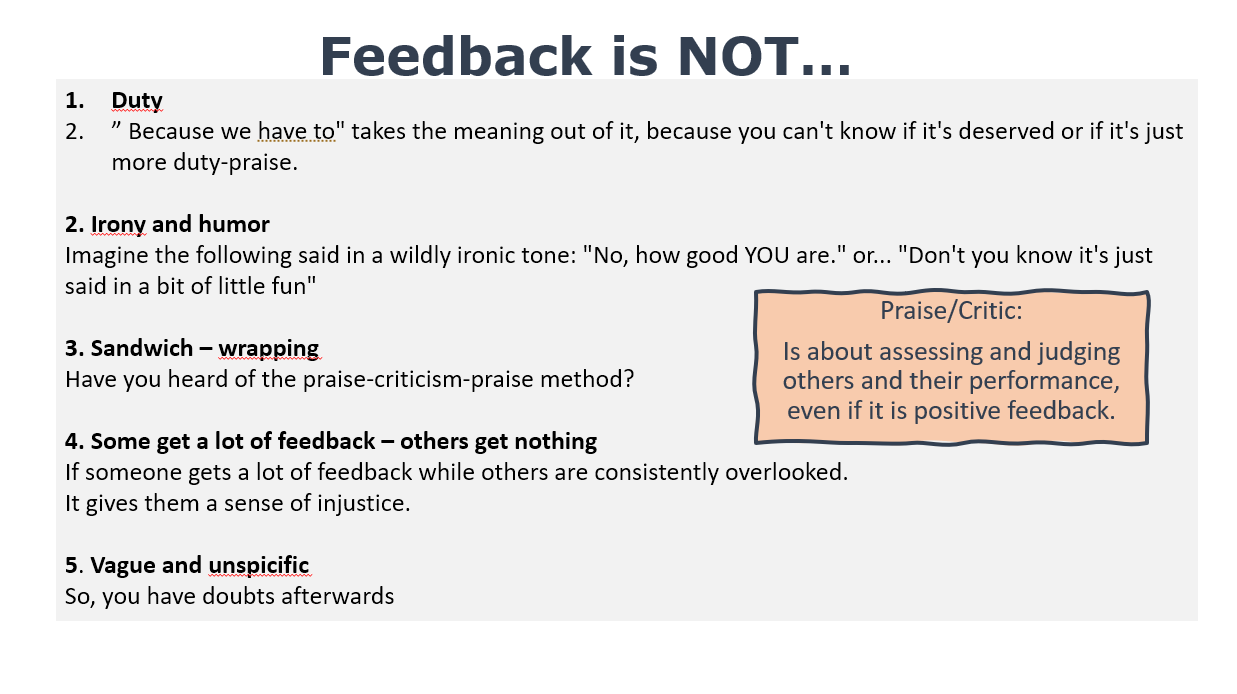Create a constructive feedback culture
An important part of your approach to other people
Giving and receiving feedback is an important tool in communicating with others. It's all about the approach to other people. Focusing solely on mistakes is an approach that drains the work environment and weakens communication, which also has a decisive influence on you as colleagues not being able to "play well together". Being receptive to feedback is fundamentally about being open-minded to the opinions of others. The belief that everyone acts in a meaningful way contributes to a constructive feedback culture where you can be honest and open with each other in a respectful way.
One way to expand your self-awareness is through feedback from others. This way, you can become aware of things that you are not aware of yourself. Similarly, by giving feedback to your colleagues, you can help them become an even better version of themselves. When receiving feedback, it's all about listening. Be aware that all feedback always has good intentions and is always well-intentioned. Listen and make sure you understand! Ask if there is anything you would like to clarify and say thank you. This way, you avoid unnecessary conflicts around feedback.
REMEMBER: Thoughtless feedback creates conflict, while thoughtful feedback contributes to conflict prevention and de-escalation!
It's also essential to be aware of what we are signaling with our communication. Always remember to be aware that your body language and facial expressions can erase your words and good intentions if they don't match what you want to express.
The Johari Window
The Johari Window is a theory developed by Joseph Luft and Harrington Ingham that is based on gaining insight into how those around you see you. This can have a positive impact on your collaboration as you can gain a deeper understanding of yourself and your blind spot through the eyes of your colleagues. Through mutual trust and respect for each other's strengths and weaknesses, it's possible to achieve a deeper, more meaningful and seamless collaboration. This also allows for receiving and giving feedback to become a less boundary-breaking process that can provide insight into blind spots.
Carol Dweck describes in her book:
"You are what you think - the new mindset theory on the path to success, how people with a fixed mindset believe their attributes are set in stone"
According to Dweck, this creates a tendency to avoid challenges, give up easily, see effort as futile, and feel threatened by the success of others. Individuals who have a developmental mindset, on the other hand, believe that your basic attributes can be developed through your own efforts. This means that people with a challenge-embracing mindset are persistent when challenged and see effort as the path to mastery. In addition, they typically don't feel threatened but rather learn from the successes of others.
Johari’s Window as a communication tool
The open window is the knowledge that is known both to yourself and others. For example. I am a trained waiter
The blind window is the knowledge that is unknown to myself, but known to others. For example. I say a lot of uh... when I'm nervous.
The hidden window is the knowledge you have that is not known to others. For example. That you don't drink alcohol because you're afraid of doing something embarrassing.
The unknown window contains the knowledge that you are not aware of and that others don't know about. This one is hard to give an example, but imagine that you've always had a stomach ache when the chef in the kitchen gets the flames going. Your colleagues can't see that you have a stomach ache and you don't know that this stomach ache is because you're afraid of the fire.
Source: Joseph Luft and Harrington Ingham
Watch the videos below to gain a deeper understanding of the Johari window and how to convey a difficult message
How can you use your knowledge of the blind spot when giving and receiving feedback?
Feedback is an essential tool to master both in your approach to each other as colleagues, but it's also useful to master in your approach to your manager. Thoughtless feedback can create conflict, while thoughtful feedback contributes to conflict prevention and de-escalation. Basically, you expand your self-awareness through feedback from others and, as mentioned earlier, become aware of your blind spot.
Questions can also be a form of feedback.
The ability to ask questions so that the other party reflects on any opportunities for improvement, etc. Questions can open up thoughts and feelings in other people, which makes it relevant to take into account when giving feedback. Think about whether you should ask linear or circular questions to get the most constructive answers. It is also important to consider how you formulate your questions and focus on being assertive in your delivery of the questions.
Source: Karl Tomm
Feedback can be used to expand your blind spot so that you can learn more about yourself. Consider how you give and receive feedback. What feelings does it evoke in you?
Think about how you can make yourself available for feedback and how you can best prepare to have a constructive conversation.


Curious for more?
Read on to learn how the conversation can be used as a tool and how to give and receive constructive feedback.
Or try listening to podcasts about the topic.
Listen here!



